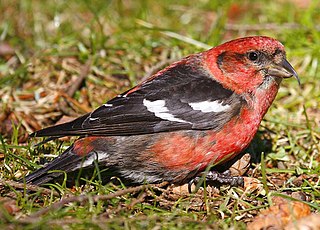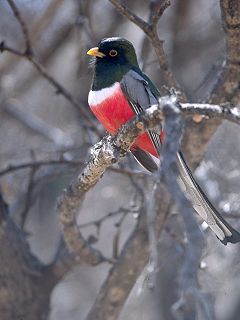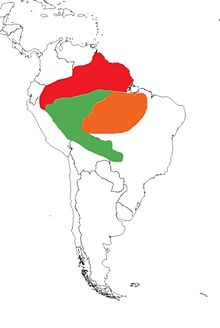
The white-winged tern, or white-winged black tern, is a species of tern in the family Laridae. It is a small species generally found in or near bodies of fresh water across much of the world, including Europe, Africa, Asia, and Australia. The genus name is from Ancient Greek khelidonios, "swallow-like", from khelidon, "swallow".

The two-barred crossbill or white-winged crossbill is a small passerine bird in the finch family Fringillidae. It has two subspecies, the white-winged crossbill in North America, and the two-barred crossbill in northeastern Europe and the Palearctic.

The little blue heron is a small heron belonging to the family Ardeidae.

The blossom-headed parakeet is a parrot which is a resident breeder in Eastern Bangladesh, Bhutan, Northeast India and Nepal, eastwards into South-east Asia and also China. It undergoes local movements, driven mainly by the availability of the fruit and blossoms which make up its diet.

The African paradise flycatcher is a medium-sized passerine bird. The two central tail feathers of the male are extended into streamers that commonly are more than twice as long as the body. The female tail feathers are of moderate length and without streamers. The upper parts of the male body, wings, and tail are boldly coloured in chestnut or rusty shades, but the underparts and the head are variably grey to blue-gray, with the head of the mature male being darker, commonly glossy black with greenish highlights. The beak and other bare areas, including a wattle ring round the eye, match the colour of the surrounding feathers. The female coloration is similar, though not so showy and glossy and with the head paler.

The grey-winged trumpeter is a member of a small family of birds, the Psophiidae. It is found in the northern Amazon rainforest and Guiana Shield in tropical South America. Unlike all other trumpeters, the rump and back are grey in the grey-winged trumpeter.

The savanna hawk is a large raptor found in open savanna and swamp edges. It was formerly placed in the genus Heterospizias. It breeds from Panama and Trinidad south to Bolivia, Uruguay and central Argentina.

The gray-headed kite is a raptor found in open woodland and swamp forests. It shares the genus Leptodon with the extremely rare white-collared kite. It breeds from eastern Mexico and Trinidad south to Peru, Bolivia, Brazil and northern Argentina.

The gray-lined hawk is a smallish raptor found in open country and forest edges. It is sometimes placed in the genus Asturina as Asturina nitida. The species has been split by the American Ornithological Society from the gray hawk. The gray-lined hawk is found from El Salvador to Argentina.

The Tahiti sandpiper or Tahitian sandpiper is an extinct member of the large wader family Scolopacidae that was endemic to Tahiti in French Polynesia.

Trogon is a genus of Coraciimorphae birds in the trogon family. Its members occur in forests and woodlands of the Americas, ranging from southeastern Arizona to northern Argentina.

The blue ground dove is a small New World tropical dove. It is a resident breeder from southeastern Mexico to northwestern Peru and northern Argentina, and on Trinidad in the Caribbean.

The red-fronted parrot, also known as Jardine's parrot, is a medium-sized mainly green parrot distributed across wide areas of Africa. It has three subspecies. The extent and shade of the red or orange plumage on its head, thighs, and bend of wings vary depending on the subspecies.

The eastern (pale) chanting goshawk or Somali chanting goshawk, is a bird of prey of East Africa.

The green aracari, or green araçari, is a toucan, a near-passerine bird. It is found in the lowland forests of northeastern South America, in the northeast Amazon Basin, the Guianas and the eastern Orinoco River drainage of Venezuela. At 30–40 cm. (12–16 in) long and weighing 110–160 grams, it is the smallest aracari in its range, and among the smallest members of the toucan family.

The pale-winged trumpeter, also known as the white-winged trumpeter, is a species of bird in the family Psophiidae. It is found in the southwestern Amazon rainforest of Brazil, northern Bolivia, and eastern Peru.

The dark-winged trumpeter is a species of bird in the family Psophiidae. It is found in the Amazon rainforest of Brazil, but only south of the Amazon River and east of the Madeira River. The eastern range of dark-winged trumpeter extends into the lower adjacent Tocantins River drainage in the Brazilian state of Pará. As of 2012, this species is listed as a vulnerable species, with the easternmost subspecies obscura rare.

The green oropendola is a species of bird in the family Icteridae. It is found in wooded habitats in the Amazon basin and Guianas of South America, and is generally common. Uniquely among the oropendolas, the green oropendola has a pale bill with an orange tip. Male oropendola weigh around 400 grams, while females are in the 200 gram range. This is a common species and the International Union for Conservation of Nature has rated its status as being of "least concern".
P. leucoptera may refer to:

The green-backed trogon, also known as the Amazonian white-tailed trogon, is a near passerine bird in the trogon family.




















